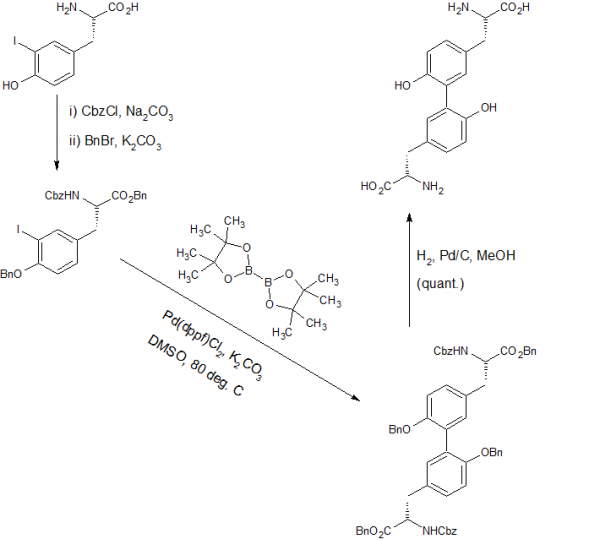Difference between revisions of "Investigating the Organic Synthesis of Dityrosine"
| Line 3: | Line 3: | ||
==Introduction== | ==Introduction== | ||
| − | New interest in peptides and proteins containing cross-linked | + | New interest in peptides and proteins containing cross-linked dityrosine residues is increasing due to fascinating biological properties they have. Some examples of said biological properties include increased stabilization of structures, conformational restriction of cyclic peptides, and variation in the electronic properties seen in enzyme active sites.[1] The possibilities of application in biological systems make tyrosine dimers a molecule of great intrigue. Dityrosine cross-linking also has a plethora of applications in the realm of biomaterials that mimic cellular environments with great potential for developing ground-breaking techniques in regenerative medicine and tissue engineering.[2] Dityrosine research also provides great insight into the progression of Alzheimer’s disease, which can be defined as the aggregation of insoluble amyloid plaques in the neuropil composed of highly stable, self-assembled Amyloid-beta42 fibrils, the neurotoxic dimerization of which is a direct result of dityrosine cross-linking.[3] These are just a few examples of the vast number of applications dityrosine has, illustrating why it is certainly a molecule worth researching. However, dityrosine is quite expensive (5 mg costs an average of $175).[4] Therefore, in order to test dityrosine and dityrosine derivatives for biological applications, it is much more financially feasible and good laboratory experience for undergraduate researchers to synthesize it themselves. |
==Synthesis== | ==Synthesis== | ||
| − | Below is the synthesis | + | Below is the proposed synthesis for dityrosine[1]: |
[[File:dityrosine_synthesis3.png|frameless|center|600px]] | [[File:dityrosine_synthesis3.png|frameless|center|600px]] | ||
Revision as of 22:50, 4 December 2020
You have reached the page dedicated to research investigating an efficient organic synthesis of the dityrosine molecule. This research is carried out by Monmouth College undergraduate Katelyn Richter under the supervision of Dr. Bradley Sturgeon.
Introduction
New interest in peptides and proteins containing cross-linked dityrosine residues is increasing due to fascinating biological properties they have. Some examples of said biological properties include increased stabilization of structures, conformational restriction of cyclic peptides, and variation in the electronic properties seen in enzyme active sites.[1] The possibilities of application in biological systems make tyrosine dimers a molecule of great intrigue. Dityrosine cross-linking also has a plethora of applications in the realm of biomaterials that mimic cellular environments with great potential for developing ground-breaking techniques in regenerative medicine and tissue engineering.[2] Dityrosine research also provides great insight into the progression of Alzheimer’s disease, which can be defined as the aggregation of insoluble amyloid plaques in the neuropil composed of highly stable, self-assembled Amyloid-beta42 fibrils, the neurotoxic dimerization of which is a direct result of dityrosine cross-linking.[3] These are just a few examples of the vast number of applications dityrosine has, illustrating why it is certainly a molecule worth researching. However, dityrosine is quite expensive (5 mg costs an average of $175).[4] Therefore, in order to test dityrosine and dityrosine derivatives for biological applications, it is much more financially feasible and good laboratory experience for undergraduate researchers to synthesize it themselves.
Synthesis
Below is the proposed synthesis for dityrosine[1]:
